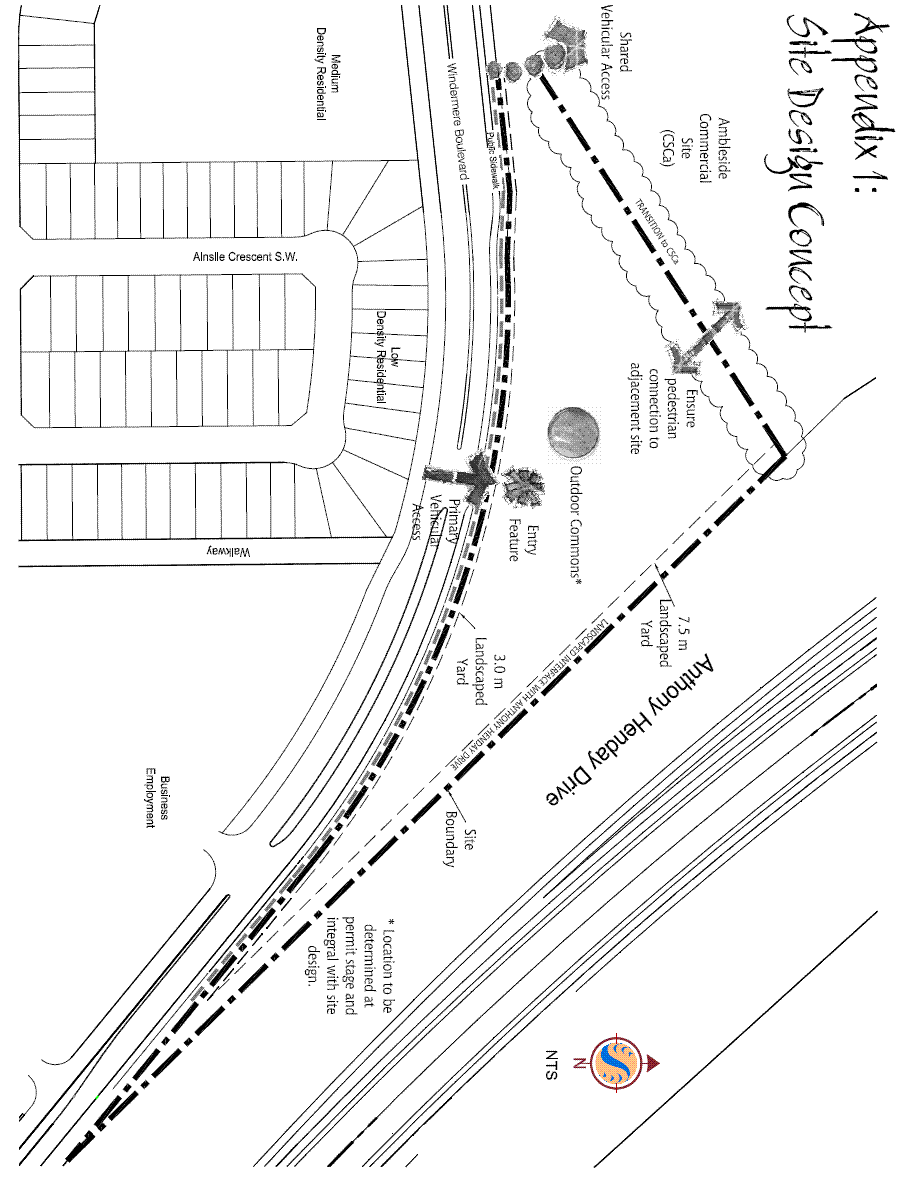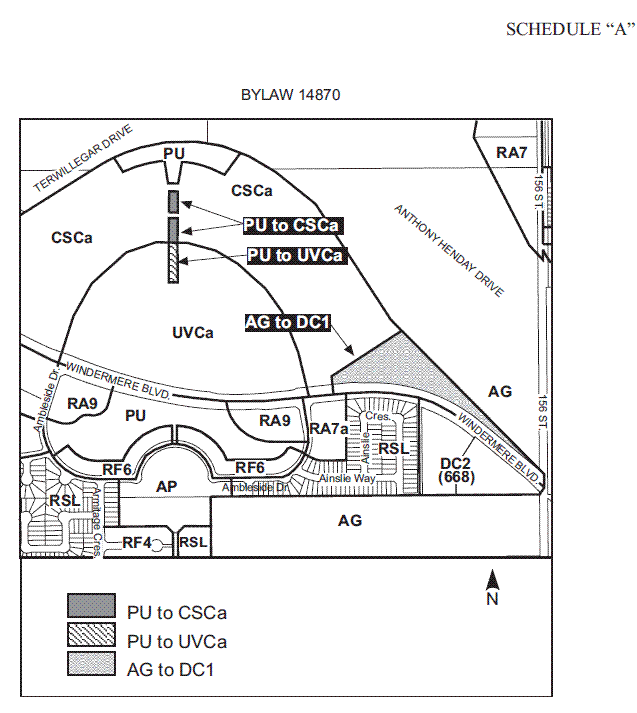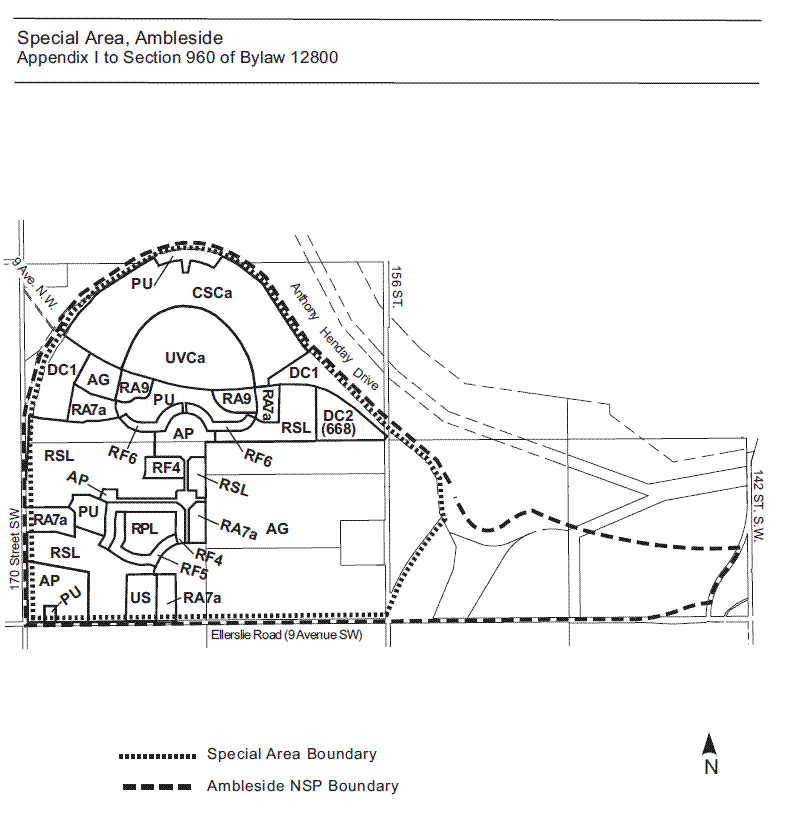(DC1) DIRECT DEVELOPMENT CONTROL PROVISION
Ambleside
Bylaw 14870
February 25, 2008
North of Windermere Boulevard and south west of Anthony Henday Drive
1. General Purpose
To accommodate the development of a range of commercial uses primarily, with the additional opportunity for a complementary mix of residential, business and institutional uses. This Provision allows the opportunity for the development of high rise buildings which may be designed in a stand alone or mixed use format for hotel, apartment and office applications, together with ancillary and complementary uses. This Provision provides development controls and urban design regulations and guidelines to establish a high quality urban environment, to ensure that the development is well integrated with the adjacent Ambleside commercial and residential areas and to create an aesthetic and architecturally appealing development adjacent to Anthony Henday Drive.
2. Area of Application
The provision shall apply to portions of Lot 1, Block 14, Plan 0723371, containing approximately 2.8 ha, immediately south west of Anthony Henday Drive and north east of Windermere Boulevard SW, Ambleside Neighbourhood, as shown on Schedule "A” of the Bylaw adopting this Provision.
3. Uses
-
Apartment Hotels
-
Apartment Housing
-
Bars and Neighbourhood Pubs
-
Business Support Services
-
Child Care Services
-
Commercial Schools
-
Community Recreation Services
-
Convenience Retail Stores
-
Convenience Vehicle Rentals, when designed as an integral component of a Hotel
-
Drive-in Food Services
-
General Retail Stores
-
Government Services
-
Health Services
-
Hotels
-
Indoor Participant Recreation Services
-
Minor and Major Amusement Establishments
-
Minor and Major Home Based Business
-
Minor Service Stations
-
Mobile Catering Food Services
-
Nightclubs, when designed as a secondary component to a Hotel, for less than 200 occupants and 240 m² of Public Space
-
Outdoor Participant Recreation Services
-
Personal Service Shops
-
Private Clubs
-
Professional, Financial and Office Support Services
-
Protective Emergency Services
-
Public and Private Education Services
-
Public Libraries and Cultural Exhibits
bb. Rapid Drive-through Vehicle Services
cc. Religious Assembly
dd. Residential Sales Centres
ee. Restaurants
ff. Specialty Food Services
gg. Spectator Entertainment Establishments
hh. Fascia Off-premises Signs
ii. Fascia On-premises Signs
jj. Freestanding Off-premises Signs
kk. Freestanding On-premises Signs
ll. Projecting On-premises Signs
mm. Roof Off-premises Signs
nn. Roof On-premises Signs
oo. Temporary On-premises Signs
4. Development Regulations
-
Development shall be in general accordance with Appendix 1, Site Design Concept, which is a schematic illustration depicting aspects of the Development and Design Regulations.
-
With build-out of the Site, Uses shall be part of a purpose-designed mixed use development characterized by:
-
predominantly commercial development in the form of low, medium and/or high rise buildings, complemented with business, institutional and/or residential Uses; and/or
-
stand alone or mixed use high rise buildings for hotel, apartment and/or office related development.
-
Floor Area Ratio:
-
the maximum total Floor Area Ratio for all combined Uses for the Site shall be 2.5, except that the maximum total Floor Area Ratio for all combined Uses for the Site Shall be 3.0 if 50% of the high rise buildings contain a mix of uses, including ground floor commercial and/or business uses;
-
the maximum Floor Area Ratio for commercial and business Uses shall be 1.0, except that Apartment Hotels, Hotels, Business Support Services and Professional, Financial and Office Support Services shall be 3.0; and
-
the maximum total Floor Area Ratio for Apartment Housing shall be 3.0.
-
The maximum Building Height shall not exceed 14.0 m, with the exception that for high rise buildings the primary Uses are one of or a mix of the following Uses, the maximum Building Height shall not exceed 60.0 m:
-
Apartment Hotels
-
Apartment Housing
-
Business Support Services
-
Government Services
-
Health Services
-
Hotels
-
Professional, Financial and Office Support Services
-
Separation Space shall be provided in accordance with Section 48 of the Zoning Bylaw, 12800.
-
A minimum contiguous landscaped Yard of 7.5 m shall be required where the site borders on Anthony Henday Drive, as generally depicted in Appendix 1, Site Design Concept.
-
A minimum contiguous landscaped Yard of 3.0 m shall be required where the Site abuts Windermere Boulevard, as generally depicted in Appendix 1, Site Design Concept.
-
A detailed Landscaping plan shall be submitted in accordance with Section 55 of the Zoning Bylaw, 12800, prior to the approval of any development permit. This plan shall include pedestrian connection and fencing details, exterior lighting and street furniture elements, pedestrian seating areas, varied sizes and species of new plantings.
-
All landscaped Yards shall contain minimum plantings as outlined in the following:
-
one tree for each 17.5 m2 and one shrub for each 10 m2 of any required Yard or Setback at grade.
-
one tree for each 17.5 m2 and one shrub for each 7.5 m2 of required parking area islands. In no case shall there be less than one tree per required parking area island.
-
All planting shall conform to the following:
-
the proportion of deciduous to coniferous trees and shrubs shall be approximately 50:50 and the following mix of tree sizes shall be used;
-
100% of required deciduous trees shall be a minimum 75 mm caliper; and
-
75% of required coniferous trees shall be a minimum of 2.5 m in height and 25% shall be a minimum 3.5 m in height.
-
No parking, loading, storage, trash collection, outdoor service or display area shall be permitted within a required Yard. Loading, storage and trash collection areas shall be located to the rear or sides of the principal building and shall be screened from view from any adjacent Sites, public roadways or Light Rail Transit lines, in accordance with the provisions of subsection 55.4 of the Zoning Bylaw, 12800. If the rear or sides of a Site are used for parking, an outdoor service or display area, or both, and abut a Residential Zone or a Lane serving a Residential Zone, such areas shall be screened in accordance with the provisions of subsection 55.4 of the Zoning Bylaw, 12800.
-
Signs shall comply with the regulations found in Schedule 59E of this Bylaw, with the intent to complement the pedestrian-oriented commercial environment, except that:
-
The maximum Height of a Freestanding Sign shall be 8.0 m.
-
A Projecting Sign may be used to identify businesses.
-
The top of a Projecting Sign on a Building two Storeys or higher shall not extend more than 75 cm above the floor of the second or third Storey, nor higher than the windowsill of the second or third Storey.
-
No single General Retail Store shall exceed 5,000 m2 of floor area.
-
The design of the transition zone shown on Appendix 1, Site Design Concept, shall ensure the following:
-
Connection of pedestrian and vehicular circulation with the adjacent Site to the west zoned CSCa (Ambleside Shopping Center); and
-
Architecture and urban design elements that complement the adjacent Site to the west zoned CSCa (Ambleside Shopping Center).
5. Design Regulations
-
Building Design and Architectural Standards
-
An architectural theme shall be established for the entire Site to ensure consistency of design elements such as building design, layout, finishing materials and colours, signage and landscape treatments.
-
Any canopies shall be designed and finished in a manner consistent with the design and finishing of the principal building.
-
Design techniques including, but not limited to, the use of sloped roof, variations in building setbacks and articulation of building facades shall be utilized in order to minimize the perception of massing of the building when viewed from adjacent Sites and public roadways.
-
Building facades (all sides) shall include design elements, finishing materials and variations that will reduce any perceived mass and linearity of large buildings and add architectural interest.
-
The roof line of buildings shall consist of sloped roofs of varying pitches which may be finished in any combination of metal, wood shakes, asphalt shingles, clay tiles, or roof materials having a similar texture and appearance or flat roofs where they are concealed by parapet walls that include articulation and use of design elements that are in harmony with the principal architectural theme that reduce any perceived mass and linearity of large buildings and add architectural interest;
-
To reduce any perceived mass and linearity of large buildings and add architectural interest, the exterior finishing materials shall incorporate vertical elements using a combinations of brick, stone or other masonry materials, concrete, stucco, glazing or siding, having a similar character, with wood or metal trim, having regard to the objective of ensuring that the development is of a high quality and complementary theme. Abrupt and excessive differences in scale of adjacent buildings shall be minimized through transitional building treatment.
-
Primary emphasis shall be placed on design elements and façade enhancements, particularly to the first and second levels of buildings to create a pedestrian friendly environment. Lower floors shall be articulated to add variety, interest and a human scale dimension. Recommended design elements include placement of windows to allow for viewing into the building by pedestrians; transparency of windows; wall niches; entrance features; street furniture; canopies and features that lend visual interest and create a human scale.
-
Smaller buildings shall incorporate complementary materials and architectural detailing to be consistent with the larger buildings.
-
Functional and decorative lighting shall be provided within the development to enhance the appearance of the Site and buildings.
-
Any building backing on to Anthony Henday Drive or fronting onto Windermere Boulevard shall use special architectural treatment for building corners.
-
Any single wall length greater than 15.0 m visible from a public road shall use articulation in the wall to minimize the perceived mass of the building.
-
Building entrances shall be readily identifiable by using design elements such as distinctive materials and colours, human scale architecture, recessing, canopies, awnings, overhangs, articulation, projections and columns.
-
All mechanical equipment, including roof mechanical units, shall be concealed by screening with design elements that are compatible or complement the architectural character and materials of the building, or concealed by incorporating it within the building framework.
-
Pedestrian Environment
-
The development shall create a pedestrian friendly environment, which may include a combination of:
-
entrance feature(s)
-
pedestrian/directional signage
-
outdoor seating areas
-
canopies
-
landscaping and street furniture
-
convenient access to parking
-
public art
-
small parks, squares, plazas and/or greens
-
An outdoor commons area shall be provided, as generally depicted in Appendix 1, Site Design Concept, and shall be connected to the pedestrian circulation system for the Site.
-
Development within this site shall ensure that the design of the pedestrian environment is comfortable, convenient, visually attractive and safe for human activity.
-
Pedestrian pathways to building entrances, amenities and transit shall be convenient, safe and well lit, with special paving or landscaping to define the connections.
-
Internal pedestrian corridors shall connect buildings and uses to amenity area(s) and adjacent land uses, (including the transit stops, Windermere Boulevard, multi-use trails, and the adjacent commercial and residential areas).
-
A pedestrian connection, as generally depicted on Appendix 1, Site Design Concept, shall be required to link to an internal pedestrian route within the adjacent Site to the west zoned CSCa (Ambleside Shopping Centre).
-
Access, Circulation and Parking
-
The primary vehicular access to the Site shall be from Windermere Boulevard, and shared vehicular access shall be provided between the Site and the Site to the west zoned CSCa (Ambleside Shopping Centre), as generally depicted in Appendix 1, Site Design Concept.
-
Parking for the site shall be provided in accordance with Section 54 of the Zoning Bylaw.
-
Internal and perimeter streets shall be tree lined and lit with appropriate lighting.
-
Developments shall provide walkways along primary buildings.
-
Parking areas shall be designed for safe and orderly movement.
-
Parking areas shall be designed to minimize pedestrian/vehicular conflict.
-
Parking areas adjacent to Windermere Boulevard shall include landscaping between the roadway and parking stalls to create an aesthetic buffer and to reduce visual impact.
-
Parking for the Site shall be one of, or a combination of underground parking, structured (above ground) parking and/or surface parking.
-
Structured parking shall complement the architectural features of the adjacent building(s).
-
No structured parking shall front onto Windermere Boulevard.
-
Landscaping
-
Open space shall feature high quality landscape architecture intended to make spaces comfortable and enjoyable including such features as trees, street furniture and public art.
-
Coordinated and complementary streetscape enhancements shall be applied, including street trees, fencing, pedestrian scaled lighting, street furniture and other amenities.
-
Landscaping shall be used to highlight major circulation patterns, pedestrian pathways and to provide cohesiveness to the overall development.
-
Landscaping of the Site shall include plant materials that provide colour and texture throughout the year to enhance the appearance during non-growing months.
-
Landscaping shall complement the overall Site and include a combination of plant material that provides visual interest.
-
The outdoor commons, generally depicted in Appendix 1, Site Design Concept, shall be landscaped with one or a combination of elements described in regulations 5 d) i) and 5 d) ii).
-
Site landscaping shall be used to soften the building form. Recommended landscaping treatments may include one or a combination of tree and shrub planting, water features, railings, curbs, low walls, fences, berms, walkways, amenity areas and public art.
-
A Site entry feature is required at the primary all directional access to the Site along Windermere Boulevard, as generally depicted in Appendix 1, Site Design Concept. This entry feature shall include trees and shrubs, accents, paving treatments, lighting and/or compatible architectural elements.
-
Along Anthony Henday Drive, the rear of the Site shall reflect a formalized landscape treatment to break-up the façade of building walls, enhance views and screen parking lots, and service areas from the traveling public.
-
A 1.2 m continuous screen fence shall be located within private property lines along the portion of the Site adjacent to Anthony Henday Drive.
-
Signage
-
A Comprehensive Sign Design Plan and Schedule shall be submitted, consistent with the overall intent of subsection 59.3 of the Zoning Bylaw, 12800, prior to the approval of any development permit.
-
Signs shall be designed to reflect an aesthetically pleasing and cohesive approach to complement the architectural features of all buildings.
-
Individual business identification signs located on the façades of buildings shall be similar in proportion, construction materials and placement. The design, scale and placement of signs shall be such that the signage does not detract from the overall appearance of the development and that the signage is not obtrusive, having regard to the scale of the buildings on the Site and to the distance of the building Setback.
-
Directional signage shall provide wayfinding information at critical locations relating to tenants, pedestrian movement, parking lots, loading zones and pick up areas, entrances, exits and amenity areas.
-
Movement and brightness of signage shall be designed to minimize light pollution and visual intrusion on surrounding residential properties.
-
CPTED and Accessibility
-
CPTED principles shall be used to design all public and private spaces and facilities focusing natural surveillance and access control to lessen the likelihood of crime within the Site.
6. Design Guidelines
-
Pedestrians should be protected from the weather through the provision of canopies, awnings, overhangs or covered walkways where practical.
-
Buildings located adjacent to Windermere Boulevard are encouraged to be designed with active frontages and to provide building entry-ways facing Windermere Boulevard for direct pedestrian access to the public street.
-


